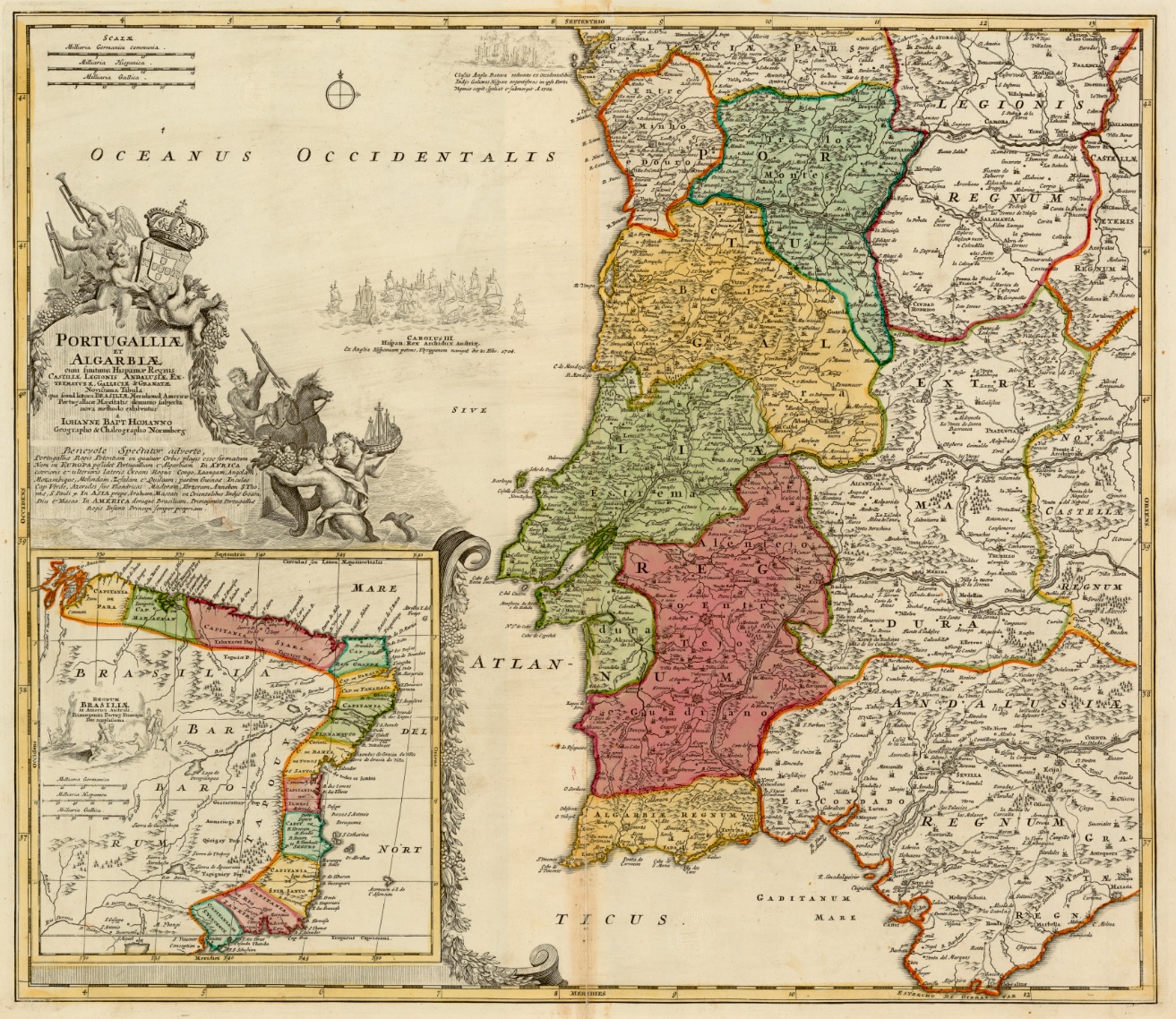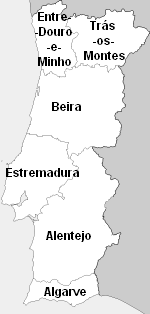|
Historical Province Of Portugal
The term "provinces" ( pt, províncias) has been used throughout history to identify regions of continental Portugal. Current legal subdivisions of Portugal do not coincide with the provinces, but several provinces, in their 19th- and 20th-century versions, still correspond to culturally relevant, strongly self-identifying categories. They include: *Alentejo * Algarve * Beira * Douro Litoral * Estremadura * Minho * Ribatejo *Trás-os-Montes The islands of Azores and Madeira were never called "provinces". History The first provinces, instituted during the Roman occupation of the Iberian peninsula, divided the peninsula into three areas: Tarraconensis, Lusitania and Baetica, established by Roman Emperor Augustus between 27–13 B.C. Emperor Diocletian reordered these territories in the third century, dividing Tarraconesis into three separate territories: Tarraconensis, Carthaginensis and Gallaecia. At that time Tarraconesis included northern Portugal, Gallaecia and Ast ... [...More Info...] [...Related Items...] OR: [Wikipedia] [Google] [Baidu] |
NUTS Statistical Regions Of Portugal
The Nomenclature of Territorial Units for Statistics (NUTS) is developed by Eurostat, and employed in both Portugal and the entire European Union for statistical purposes. The NUTS branch extends from NUTS1, NUTS2 and NUTS3 regions, with the complementary LAU (''Local Administrative Units'') sub-categorization being used to differentiate the local areas, of trans-national importance. Developed by Eurostat and implemented in 1998, the Nomenclature of Territorial Units for Statistics (NUTS) regions, which comprises three levels of the Portuguese territory, are instrumental in European Union's Structural Fund delivery mechanisms. The standard was developed by the European Union and extensively used by national governments, Eurostat and other EU bodies for statistical and policy matters. Until 4 November 2002, the ''Sistema Estatístico Nacional'' (SEN) used a NUTS codification system that was distinct from the Eurostat system. With the enactment of Decree Law 244/2002 (5 November 20 ... [...More Info...] [...Related Items...] OR: [Wikipedia] [Google] [Baidu] |
Augustus
Caesar Augustus (born Gaius Octavius; 23 September 63 BC – 19 August AD 14), also known as Octavian, was the first Roman emperor; he reigned from 27 BC until his death in AD 14. He is known for being the founder of the Roman Principate, which is the first phase of the Roman Empire, and Augustus is considered one of the greatest leaders in human history. The reign of Augustus initiated an imperial cult as well as an era associated with imperial peace, the ''Pax Romana'' or ''Pax Augusta''. The Roman world was largely free from large-scale conflict for more than two centuries despite continuous wars of imperial expansion on the empire's frontiers and the year-long civil war known as the "Year of the Four Emperors" over the imperial succession. Originally named Gaius Octavius, he was born into an old and wealthy equestrian branch of the plebeian ''gens'' Octavia. His maternal great-uncle Julius Caesar was assassinated in 44 BC, and Octavius was named in Caesar' ... [...More Info...] [...Related Items...] OR: [Wikipedia] [Google] [Baidu] |
Trás-os-Montes Province
Trás-os-Montes Province () is one of the medieval provinces of Portugal. The northern part is covered by Terras de Trás-os-Montes and Alto Tâmega, the southern by Douro Subregion. See also * Trás-os-Montes (region) * Trás-os-Montes e Alto Douro Province Trás-os-Montes e Alto Douro () is a historical province of Portugal located in the northeastern corner of the country. Vast plateaus, river valleys, mountains, and castles abound in Trás os Montes e Alto Douro. History A first attempt to regis ... {{DEFAULTSORT:Tras-Os-Montes Province Former provinces of Portugal ... [...More Info...] [...Related Items...] OR: [Wikipedia] [Google] [Baidu] |
Comarca
A ''comarca'' (, or , or ) is a traditional region or local administrative division found in Portugal, Spain and some of their former colonies, like Brazil, Nicaragua, and Panama. The term is derived from the term ''marca'', meaning a "march, mark", plus the prefix ''co''-, meaning "together, jointly". The ''comarca'' is known in Aragonese as ''redolada'' () and in Basque as ''eskualde'' (). In addition, in Galician, ''comarcas'' are also called ''bisbarras'' (). Although the English word "county" and its near synonym "shire" have similar meanings, they are usually translated into Spanish and Portuguese as ''condado'', a term which in the Iberian peninsula only refers to regions historically ruled by a ''conde'' (count or earl). However, "comarca" is occasionally used, with examples including the Spanish Wikipedia entry for "comarca" and some translations of The Lord of the Rings (see below). In the CPLP In the Community of Portuguese Language Countries (CPLP), ''coma ... [...More Info...] [...Related Items...] OR: [Wikipedia] [Google] [Baidu] |
Alfonso III Of León
Alfonso III (20 December 910), called the Great ( es, el Magno), was the king of León, Galicia and Asturias from 866 until his death. He was the son and successor of Ordoño I. In later sources he is the earliest to be called "Emperor of Spain." He was also titled "Prince of all Galicia" (''Princeps totius Galletiae''). Life Alfonso's reign was notable for his comparative success in consolidating the kingdom during the weakness of the Umayyad princes of Córdoba. He fought against and gained numerous victories over the Muslims of al-Andalus. During the first year of his reign, he had to contend with a usurper, Count Fruela of Galicia. He was forced to flee to Castile, but after a few months Fruela was assassinated and Alfonso returned to Oviedo. He defeated a Basque rebellion in 867 and, much later, a Galician one as well. He conquered Porto and Coimbra in 868 and 878 respectively. In about 869, he formed an alliance with the Kingdom of Pamplona, and solidified this lin ... [...More Info...] [...Related Items...] OR: [Wikipedia] [Google] [Baidu] |
County Of Portugal
The County of Portugal ( pt, Condado de Portugal, Condado Portucalense, Condado de Portucale; in documents of the period the name used was Portugalia) refers to two successive medieval counties in the region around Braga and Porto, today corresponding to littoral northern Portugal, within which the identity of the Portuguese people formed. The first county existed from the mid-ninth to the mid-eleventh centuries as a vassalage of the Kingdom of Asturias and the Kingdom of Galicia and also part of the Kingdom of León, before being abolished as a result of rebellion. A larger entity under the same name was then reestablished in the late 11th century and subsequently elevated by its count in the mid-12th century into an independent Kingdom of Portugal. First county The history of the county of Portugal is traditionally dated from the '' reconquest'' of ''Portus Cale'' (Porto) by Vímara Peres in 868. He was named a count and given control of the frontier region between the Limi ... [...More Info...] [...Related Items...] OR: [Wikipedia] [Google] [Baidu] |
Visigoth
The Visigoths (; la, Visigothi, Wisigothi, Vesi, Visi, Wesi, Wisi) were an early Germanic people who, along with the Ostrogoths, constituted the two major political entities of the Goths within the Roman Empire in late antiquity, or what is known as the Migration Period. The Visigoths emerged from earlier Gothic groups, including a large group of Thervingi, who had moved into the Roman Empire beginning in 376 and had played a major role in defeating the Romans at the Battle of Adrianople in 378. Relations between the Romans and the Visigoths varied, with the two groups making treaties when convenient, and warring with one another when not. Under their first leader, Alaric I, the Visigoths invaded Italy and sacked Rome in August 410. Afterwards, they began settling down, first in southern Gaul and eventually in Hispania, where they founded the Visigothic Kingdom and maintained a presence from the 5th to the 8th centuries AD. The Visigoths first settled in southern Gaul as ''foe ... [...More Info...] [...Related Items...] OR: [Wikipedia] [Google] [Baidu] |
Reconquista
The ' (Spanish, Portuguese and Galician for "reconquest") is a historiographical construction describing the 781-year period in the history of the Iberian Peninsula between the Umayyad conquest of Hispania in 711 and the fall of the Nasrid kingdom of Granada in 1492, in which the Christian kingdoms expanded through war and conquered al-Andalus; the territories of Iberia ruled by Muslims. The beginning of the ''Reconquista'' is traditionally marked with the Battle of Covadonga (718 or 722), the first known victory by Christian military forces in Hispania since the 711 military invasion which was undertaken by combined Arab- Berber forces. The rebels who were led by Pelagius defeated a Muslim army in the mountains of northern Hispania and established the independent Christian Kingdom of Asturias. In the late 10th century, the Umayyad vizier Almanzor waged military campaigns for 30 years to subjugate the northern Christian kingdoms. His armies ravaged the north, even s ... [...More Info...] [...Related Items...] OR: [Wikipedia] [Google] [Baidu] |
Kingdom Of León
The Kingdom of León; es, Reino de León; gl, Reino de León; pt, Reino de Leão; la, Regnum Legionense; mwl, Reino de Lhion was an independent kingdom situated in the northwest region of the Iberian Peninsula. It was founded in 910 when the Christian princes of Asturias along the northern coast of the peninsula shifted their capital from Oviedo to the city of León. The kings of León fought civil wars, wars against neighbouring kingdoms, and campaigns to repel invasions by both the Moors and the Vikings, all in order to protect their kingdom's changing fortunes. García is the first of the kings described by the charters as reigning in León. It is generally assumed that the old Asturian kingdom was divided among the three sons of Alfonso III of Asturias: García (León), Ordoño ( Galicia) and Fruela (Asturias), as all three participated in the deposition of their father. When García died in 914, León went to Ordoño, who now ruled both León and Galicia as Ordo� ... [...More Info...] [...Related Items...] OR: [Wikipedia] [Google] [Baidu] |
Asturias
Asturias (, ; ast, Asturies ), officially the Principality of Asturias ( es, Principado de Asturias; ast, Principáu d'Asturies; Galician-Asturian: ''Principao d'Asturias''), is an autonomous communities of Spain, autonomous community in northwest Spain. It is coextensive with the provinces of Spain, province of Asturias and contains some of the territory that was part of the larger Kingdom of Asturias in the Middle Ages. Divided into eight Comarcas of Asturias, ''comarcas'' (counties), the autonomous community of Asturias is bordered by Cantabria to the east, by Province of León, León (Castile and León) to the south, by Province of Lugo, Lugo (Galicia (Spain), Galicia) to the west, and by the Cantabrian Sea, Cantabrian sea to the north. Asturias is situated in a mountainous setting with vast greenery and lush vegetation, making it part of Green Spain. The region has a oceanic climate, maritime climate. It receives plenty of annual rainfall and little sunshine by Spanish ... [...More Info...] [...Related Items...] OR: [Wikipedia] [Google] [Baidu] |
Gallaecia
Gallaecia, also known as Hispania Gallaecia, was the name of a Roman province in the north-west of Hispania, approximately present-day Galicia, northern Portugal, Asturias and Leon and the later Kingdom of Gallaecia. The Roman cities included the port Cale (Porto), the governing centers Bracara Augusta (Braga), Lucus Augusti (Lugo) and Asturica Augusta (Astorga) and their administrative areas Conventus bracarensis, Conventus lucensis and Conventus asturicensis. Description The Romans named the northwest part of Hispania or the Iberian Peninsula ''Gallaecia'' after the celtic tribes of the area the Gallaeci or Gallaecians. The Gallaic make their entry into written history in the first-century epic ''Punica'' of Silius Italicus on the First Punic War: :''Fibrarum et pennae divinarumque sagacem'' :''flammarum misit dives Callaecia pubem,'' :''barbara nunc patriis ululantem carmina linguis,'' :''nunc pedis alterno percussa verbere terra,'' :''ad numerum resonas gaudentem ... [...More Info...] [...Related Items...] OR: [Wikipedia] [Google] [Baidu] |




.jpg)
